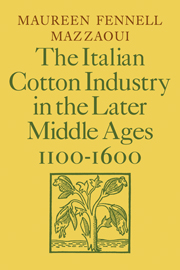Book contents
- Frontmatter
- Contents
- List of illustrations
- Preface
- List of abbreviations
- Map
- Introduction
- PART ONE THE ROLE OF COTTON IN THE MEDITERRANEAN ECONOMY
- PART TWO THE ORGANIZATION OF THE NORTH-ITALIAN INDUSTRY
- PART THREE THE GROWTH OF COTTON MANUFACTURE NORTH OF THE ALPS
- 7 Italy and south Germany 1300–1600
- 8 European cotton manufacture on the eve of the Industrial Revolution
- APPENDICES
- Notes
- Select bibliography
- Index
8 - European cotton manufacture on the eve of the Industrial Revolution
Published online by Cambridge University Press: 05 March 2012
- Frontmatter
- Contents
- List of illustrations
- Preface
- List of abbreviations
- Map
- Introduction
- PART ONE THE ROLE OF COTTON IN THE MEDITERRANEAN ECONOMY
- PART TWO THE ORGANIZATION OF THE NORTH-ITALIAN INDUSTRY
- PART THREE THE GROWTH OF COTTON MANUFACTURE NORTH OF THE ALPS
- 7 Italy and south Germany 1300–1600
- 8 European cotton manufacture on the eve of the Industrial Revolution
- APPENDICES
- Notes
- Select bibliography
- Index
Summary
For approximately 250 years (1350–1600) the Lombard and the Swabian industries were the primary suppliers of cotton goods to the rest of Europe. Their hegemony was seriously undermined in the last decades of the sixteenth century as the cotton trade shifted away from Venice and Genoa to the western-Mediterranean and Atlantic ports of Marseilles, Rouen and Amsterdam. Although Levant grades still predominated, New World and especially Brazilian cotton was increasingly represented in incoming cargos. These supplies were channeled toward new cotton industries in northern Europe. In the seventeenth century European markets were further disrupted by the Thirty Years War which crippled Swabian production. In addition, Italian and German producers faced growing competition from Dutch imports of Indian calicos. As a result of these pressures, the traditional manufacturing centers entered a period of rapid and unrelieved decline.
The downward slide can be clearly traced in Cremona. According to the registers of the University of Merchants of Cremona, ‘a great number’ of fustians and valesine were still manufactured in that city in 1588. However, the industry entered into crisis in the first half of the seventeenth century. The number of firms producing cotton cloth rose gradually from 91 in 1615 to 138 in 1627 and then fell precipitously to 60 in 1631 and 41 in 1648. The moderate rise in guild membership between 1615 and 1627 did not indicate an increase in production.
- Type
- Chapter
- Information
- The Italian Cotton Industry in the Later Middle Ages, 1100–1600 , pp. 154 - 162Publisher: Cambridge University PressPrint publication year: 1981



